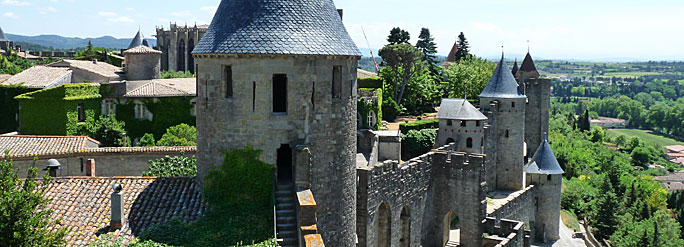Cycling the Languedoc (Plus! French Catalonia)
With a variety of landscapes bathed by the Mediterranean sun and connected with a vast network of small country roads that extend from the sea to the mountains, the Languedoc is a region ideally discovered by bicycle. Experience all of the character of southern France cycling through picturesque small villages built of sun-toasted limestone enlivened by center squares filled with farmer’s markets, locals gossiping over their pastis drinks, and heated games of boules played with heavy steels balls polished by the calloused hands of French retirees. The Languedoc’s Mediterranean coast lined with beaches and lagoons quickly gives way to the garrigues shrub land of oak, lavender, rosemary and thyme which itself is bordered by dense forests and mountain peaks creating an extraordinary natural amphitheater from the Rhône river delta to the Pyrenees mountains. There is also the opportunity for a unique perspective of the Cévennes mountains with an exciting canoe descent down the Hérault river gorge. Local tourism thrives in the Languedoc but has not given way to the bustle of mass tourism resulting in a network of rural roads not much larger than a bike path often without a car in sight.
In addition to its natural beauty and Mediterranean feel the Languedoc is home to some fascinating historical events and sites. Our tour begins in Nimes where an almost 2000-year-old Roman arena still stands in its center. Once used for chariot races and gladiator combats it now hosts, among other events, the largest Spanish-style bull fights in France. Continuing on our route by bicycle we approach the medieval fortified city of Carcassonne with its double ring of ramparts and 53 towers you might seriously wonder what century you are in. As we arrive at the foothills of the Pyrenees the perched remnants of Cathar castles bear witness to the Albigensian crusade (check out Monica’s review of Labyrinth to learn more) and one of the most powerful heretic movements in French history. These castles were a refuge for those who dared to defy the pope and in turn saw their lands and lives taken by French nobles in a massive military campaign.
Continue on the 11 day Plus! French Catalonia itinerary and discover that the Languedoc stands apart from other areas in the south of France because it contains a unique twist of Occitan and Catalan identity. In the Middle Ages there were actually two Romance languages spoken in France. In the north it was langue d’oil and in the south it was langue d’oc from which the region actually derives its name. This southern language and the dialects that were born out of it became known as Occitan. You can hear it spoken all throughout the Languedoc but its frequency and fervor grows towards the end of our tour when we enter French Catalonia. Today’s border between France and Spain does not divide its cultural similarities and in fact Occitan’s closest relative is Catalan, the official language of Catalonia and its capital, Barcelona. The historical and geographical unity of the Catalan people has created an ardent sense of pride that is expressed not only in their language but in their customs and food, which brings us to one of the most important elements of the Languedoc’s culture: its cuisine.
Graced by a generous Mediterranean sun (Montpellier, the capital of the Languedoc, boasts 300 days of sun a year!), the proximity of the sea and the rich soil of the plains, the Languedoc produces some of the freshest and tastiest dishes in France. The herbs from its garrigues vegetation are used to flavor both the meat and fish not to mention that the free range sheep and cattle regularly feast on these wild herbs. A dish inseparable both from the Languedoc and the French identity itself is the famous cassoulet. Slow-cooked with a white bean from Lauragais, a region southeast of Toulouse, the dish varies depending on which city you are in and can be made with duck, goose, lamb, pork or pheasant any of which melts in your mouth if you know the right chef. Legend has it that the inhabitants of Castelnaudry approaching starvation ate this dish when under siege by the English during the Hundred Years’ war after which they received a surge of strength and were able to force the English into retreat. Legends aside, there is of course one specialty that you can’t miss on this tour, the crema catalana which is the Catalan version of the crème brûlée made with cinnamon and anise. To accompany the numerous delicacies in its rich region, the Languedoc has developed a long tradition of wine making born from the first vines planted by the Greeks and Romans more than two centuries ago that has since been cultivated into the largest wine producing region in the world.
We have been inspired by all the wonderful aspects the Languedoc region has to offer and have created 8 and 11 day itineraries designed to give you an authentic look at its natural variety, historical uniqueness, and culinary specialties that are just waiting to be discovered. We hope you’ll join us next year for a unique experience and a spectacular cycling vacation.
For further inspiration visit our photo gallery.


